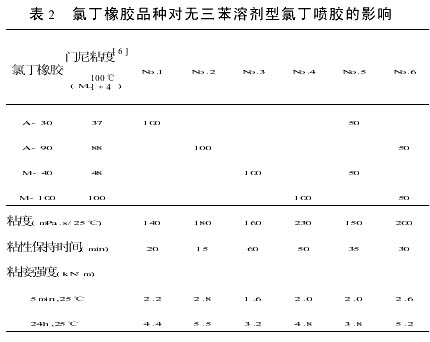Take the mixed solvent methyl ethyl ketone / acetone / n-hexane volume ratio of 1/1/1, change the chloroprene rubber varieties (A-30, A-90, M-40, M-100) and their combinations (50/50), According to the above experimental procedure, a non-triphenyl-containing neoprene spray with a solids content of 25% was prepared and its viscosity, viscosity retention time and adhesive strength were measured. The results are shown in Table 2.

As can be seen from Table 2, the low Mooney viscosity, high crystallization rate of A-30 grade neoprene (No. 1), or the low Mooney viscosity, medium crystallization rate of M-40 grade neoprene ( No. 3), or a mixture of the two (No. 5), produced a triphenylene-based neoprene sprayer with low viscosity, poor initial adhesion and bonding strength, and used alone or in combination with M-40 The spray adhesive has the longest retention time or a corresponding increase. Using a single Mooney viscosity, high crystallization rate of A-90 grade neoprene (No. 2), the triphenylene solvent-free neoprene sprayer produced has a low viscosity and a short drillability retention time, but at the beginning Tack force and bond strength are the highest, but with the middle Mooney viscosity and moderate crystallization rate of M-100 grade neoprene rubber (No. 4), the triphenyl solvent-free neoprene spray adhesive produced has the highest viscosity and maintains the viscosity. The time is longer, but the initial tack is low, and the bond strength is moderate; but after mixing the two (No. 6), the viscosity and viscosity retention time of the neoprene-free neoprene sprayer obtained is moderate, the initial tack force and Higher bonding strength and better sprayability for construction.
2.3 Tackifier Effect
Take a mixed solvent of methyl ethyl ketone / acetone / n-hexane volume ratio of 1/1/1, select A-90 grades and M-100 grade neoprene rubber mixing ratio of 1/1, according to the above experimental procedure to obtain a solids content of 25% No benzene-based neoprene spray was used as a blank, and each type of tackifier resin was added to the total amount of 2% to test its viscosity, tack retention time, and adhesive strength. The results are shown in Table 3.

As can be seen from Table 3, in the absence of benzene-based neoprene spray adhesive, the viscosity of all types of tackifying resins was slightly increased, including t-butyl phenolic resin containing 12% to 16% of methylol groups. The tack retention time is shortened, the initial tack force and the bond strength are increased; the terpene phenolic resin, the terpene resin and the rosin modified phenolic resin make the tack retention time slightly shorter, the initial tack force and the bond strength increase slightly: low The softening point of the rosin glyceride and the Coumarone resin resulted in an extension of the tack retention time, and a slight decrease in the initial tack force and the bond strength. The results showed that the use of tert-butyl phenolic resin as a tackifier resin without benzene-based neoprene spray is satisfactory, with moderate viscosity and viscosity retention time, high initial tack and adhesive strength, and Good construction sprayability.
3 Conclusion
To prepare the non-triphenyl solvent-based neoprene spray, it is best to choose the following conditions: (1) The mixed solvent of methyl ethyl ketone/acetone/hexane is used as the volume ratio of 1/1/1. (2) The mixing ratio of the compounded A-90/M-100 neoprene rubber is 1/1. (3) Select t-butyl phenolic resin as tackifying resin. (4) Mixing neoprene rubber: 100 parts of chloroprene rubber, 4 parts of active magnesium oxide, 4 parts of active zinc oxide, and 2 parts of antioxidant. (5) Pre-reaction chelate resin: 50 parts of tert-butyl phenolic resin, 5 parts of active magnesium oxide, 1 part of catalyst, and 500 parts of triphenyl mixed solvent (polar solvent + non-polar solvent) were selected.
Source: 21st Century Fine Chemicals Network
Nail polish remover is a product specially designed to remove nail polish. It belongs to the nail polish category and can remove nail polish effectively and quickly.
The specific components are some organic matter, is the relationship between solute and solvent, just like in high school chemistry, iodine can dissolve in alcohol, benzene, carbon tetrachloride is the same. It has a similar structure and is prone to phase dissolution. In fact, you can rub a coat of nail polish on top of the nail polish and wipe it off with a paper.
How to remove the nail correctly First of all, we must choose regular manufacturers, mild and non-stimulating nail polish remover, preferably without acetone. Secondly, the amount of nail polish remover must be small. Especially when nail polish remover contains acetone, it will make the surface of the nail cuticle due to dry and become rough and fragile. When cleaning nail polish, simply saturate the cotton pad with nail polish remover in an area the size of a nail nail. Third, nail polish remover should not be used to swipe your nails. Especially those who wash nail effect is more significant products, use it to wipe the nail surface, will make the nail surface become dim, dull. Instead, press a cotton pad dampened with nail polish remover against your nails for 10 seconds, then gently rub it down from top to bottom, and the polish is mostly gone. If not, you can do it again.
Nail Polish Gel Remover,Gel Nails,Gel Polish Remover,Gel Nail Remover
DONGGUAN VOLES COMMODITY CO., LTD , https://www.volesvip.com